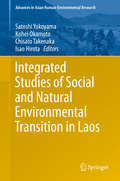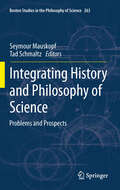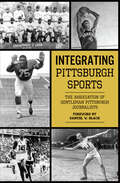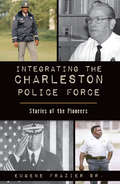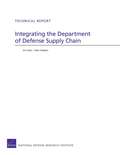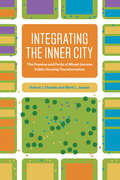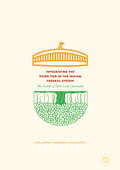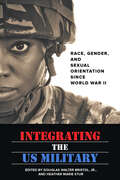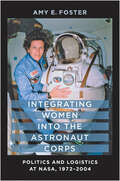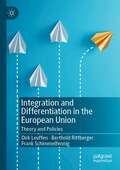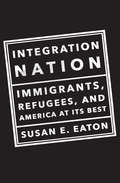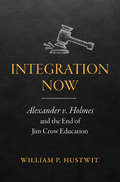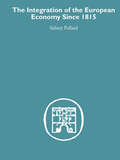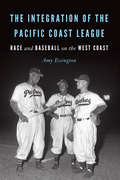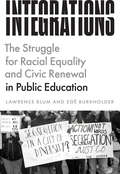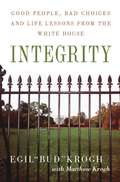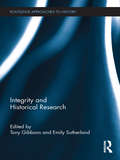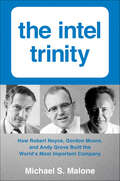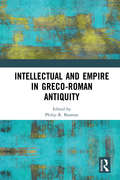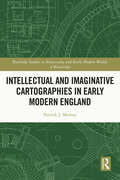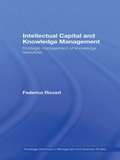- Table View
- List View
Integrated Studies of Social and Natural Environmental Transition in Laos
by Satoshi Yokoyama Kohei Okamoto Chisato Takenaka Isao HirotaThis book examines social and natural environmental changes in present-day Laos and presents a new research framework for environmental studies from an interdisciplinary point of view. In Laos, after the Lao version of perestroika, Chintanakaan Mai, in 1986, for better or worse, rural development and urbanization have progressed, and people's livelihoods are about to change significantly. Compared to those of the neighboring countries of mainland Southeast Asia, however, many traditional livelihoods such as region-specific/ethnic-specific livelihood complexes, which combined traditional rice farming with a variety of subsistence activities, have been carried over into the present in Laos. The biggest challenge this book presents is to elucidate livelihood strategies of people who cope successfully with both social and environmental changes and to illustrate how to maintain this rich social and natural environment of Laos in the future. The book includes chapters on social, cultural, and natural concerns and on ethnicity, urbanization, and regional development in Laos. All chapters are based on original data from field surveys. These data will greatly contribute not only to local studies in Laos but also to environmental studies in developing countries.
Integrating History and Philosophy of Science
by Seymour Mauskopf Tad SchmaltzThough the publication of Kuhn's Structure of Scientific Revolutions seemed to herald the advent of a unified study of the history and philosophy of science, it is a hard fact that history of science and philosophy of science have increasingly grown apart. Recently, however, there has been a series of workshops on both sides of the Atlantic (called '&HPS') intended to bring historians and philosophers of science together to discuss new integrative approaches. This is therefore an especially appropriate time to explore the problems with and prospects for integrating history and philosophy of science. The original essays in this volume, all from specialists in the history of science or philosophy of science, offer such an exploration from a wide variety of perspectives. The volume combines general reflections on the current state of history and philosophy of science with studies of the relation between the two disciplines in specific historical and scientific cases.
Integrating Pittsburgh Sports (Sports)
by The Association of Gentleman Pittsburgh JournalistSteel City Sports as a Catalyst for Change Though Pittsburgh athletics had many of the same barriers to equality and racial discrimination as the rest of the nation for far too long, the city has celebrated some of the most important moments in the integration of sports in the country. Pittsburgh was the only city with two Negro League teams, fielding such future Hall of Famers as Josh Gibson, Cool Papa Bell, Oscar Charleston and Satchel Paige. Local high school basketball stars Chuck Cooper, Bill Nunn, Jr., Dick Ricketts, Maurice Stokes, and Jack Twyman held integrated pick-up games at local parks such as Mellon Park in Shadyside in the 1950s. In college football, Connellsville native Jimmy Joe Robinson became the first African American player on Pitt's football team in 1945 as the school continued to integrate its squad ahead of federal desegregation.The Association of Gentleman Pittsburgh Journalists present the compelling, heartbreaking and courageous history of how Pittsburgh's integration of sport helped lead the nation.
Integrating the Charleston Police Force: Stories of the Pioneers (American Heritage)
by Eugene Frazier Sr.The civil rights era in the United States was a turbulent time of struggle and protest, with groups making history all across the nation. African American police officers in Charleston were immersed in their own battle to integrate local law enforcement agencies. These pioneers endured hatred and resentment within the department and sometimes from those they were sworn to protect. Lieutenant Eugene Frazier, Detective George Gathers and others fought the establishment while climbing the ranks to solve some of the toughest crimes that Charleston has ever seen. Join Frazier as he recounts the true stories of those who fought for equality.
Integrating the Department of Defense Supply Chain
by Eric Peltz Marc Robbins Geoffrey McgovernThe authors provide a framework for an integrated Department of Defense (DoD) supply chain, associated policy recommendations, and a companion framework for management practices that will drive people to take actions aligned with this integrated supply chain approach. Building on the framework and policy recommendations, they identify opportunities to improve DoD supply chain efficiency and highlight several already being pursued by DoD.
Integrating the Inner City
by Robert J. Chaskin Mark L. JosephFor many years Chicago's looming large-scale housing projects defined the city, and their demolition and redevelopment--via the Chicago Housing Authority's Plan for Transformation--has been perhaps the most startling change in the city's urban landscape in the last twenty years. The Plan, which reflects a broader policy effort to remake public housing in cities across the country, seeks to deconcentrate poverty by transforming high-poverty public housing complexes into mixed-income developments and thereby integrating once-isolated public housing residents into the social and economic fabric of the city. But is the Plan an ambitious example of urban regeneration or a not-so-veiled effort at gentrification? In the most thorough examination of mixed-income public housing redevelopment to date, Robert J. Chaskin and Mark L. Joseph draw on five years of field research, in-depth interviews, and volumes of data to demonstrate that while considerable progress has been made in transforming the complexes physically, the integrationist goals of the policy have not been met. They provide a highly textured investigation into what it takes to design, finance, build, and populate a mixed-income development, and they illuminate the many challenges and limitations of the policy as a solution to urban poverty. Timely and relevant, Chaskin and Joseph's findings raise concerns about the increased privatization of housing for the poor while providing a wide range of recommendations for a better way forward.
Integrating the Third Tier in the Indian Federal System
by Atul Sarma Debabani ChakravartyThis book discusses the evolution of the third tier of the Indian federal system, with a focus on rural local governance (commonly known as Panchayati Raj) against the backdrop of important theoretical and empirical literature on the relevance and effectiveness of service delivery in the decentralized system. It evaluates the quintessence of the functioning of the Panchayati Raj in the past two decades of its existence. This pioneering book also discusses the treatment of the third-tier government in the inter-governmental fiscal transfer framework and the delineation of the unique institution of local self-government in the Northeastern Indian States. In the light of the loosely evolved fiscal relations between three levels of government, it has been observed that local self-governments in the bottom tier have not been truly empowered yet. The book argues in favor of integrating the third-tier government into the Indian federal system and suggests how this could be achieved.
Integrating the US Military: Race, Gender, and Sexual Orientation since World War II
by Douglas Walter Bristol, Jr., and Heather Marie SturHow have the US Armed Forces been transformed by integration?One of the great ironies of American history since World War II is that the military—typically a conservative institution—has often been at the forefront of civil rights. In the 1940s, the 1970s, and the early 2000s, military integration and promotion policies were in many ways more progressive than similar efforts in the civilian world. Today, the military is one of the best ways for people from marginalized groups to succeed based solely on job performance.Integrating the US Military traces the experiences of African Americans, Japanese Americans, women, and gay men and lesbians in the armed forces since World War II. By examining controversies from racial integration to the dismantling of "Don’t Ask, Don’t Tell" to the recent repeal of the ban on women in combat, these essays show that the military is an important institution in which social change is confirmed and, occasionally, accelerated. Remarkably, the challenges launched against the racial, gender, and sexual status quo in the postwar years have also broadly transformed overarching ideas about power, citizenship, and America’s role in the world.The first comparative study of legally marginalized groups within the armed services, Integrating the US Military is a unique look at the history of military integration in theory and in practice. The book underscores the complicated struggle that accompanied integration and sheds new light on a broad range of comparable issues that affect civilian society, including affirmative action, marriage laws, and sexual harassment.
Integrating Women into the Astronaut Corps: Politics and Logistics at NASA, 1972–2004
by Amy E. FosterWhy, Amy E. Foster asks, did it take two decades after the Soviet Union launched its first female cosmonaut for the United States to send its first female astronaut into space? In answering this question, Foster recounts the complicated history of integrating women into NASA’s astronaut corps. NASA selected its first six female astronauts in 1978. Foster examines the political, technological, and cultural challenges that the agency had to overcome to usher in this new era in spaceflight. She shows how NASA had long developed progressive hiring policies but was limited in executing them by a national agenda to beat the Soviets to the moon, budget constraints, and cultural ideas about women’s roles in America. Lively writing and compelling stories, including personal interviews with America’s first women astronauts, propel Foster’s account. Through extensive archival research, Foster also examines NASA’s directives about sexual discrimination, the technological issues in integrating women into the corps, and the popular media’s discussion of women in space. Foster puts together a truly original study of the experiences not only of early women astronauts but also of the managers and engineers who helped launch them into space.In documenting these events, Foster offers a broader understanding of the difficulties in sexually integrating any workplace, even when the organization approaches the situation with as positive an outlook and as strong a motivation as did NASA.
Integration and Differentiation in the European Union: Theory and Policies
by Dirk Leuffen Berthold Rittberger Frank SchimmelfennigFar from displaying a uniform pattern, European integration varies significantly across policy areas and individual countries. Why do some member states choose to opt out of specific EU policies? Why are some policies deeply integrated whereas others remain intergovernmental? In this updated second edition, the authors introduce the most important theoretical approaches to European integration and apply these to the trajectories of key EU policy areas. Arguing that no single theory offers a completely convincing explanation of integration and differentiation in the EU, this thought-provoking book provides a new synthesis of integration theory and an original way of thinking about what the EU is and how it works.
Integration and Peace in East Africa: A History of the Oromo Nation
by Tsega EtefaThis book analyzes the development of indigenous religious, commercial, and political institutions among the Oromo mainly during the relatively peaceful two centuries in its history, from 1704 to 1882. The largest ethnic group in East Africa, the Oromo promoted peace, cultural assimilation, and ethnic integration.
Integration Nation: Immigrants, Refugees, and America at Its Best
by Susan E EatonIntegration Nation takes readers on a spirited and compelling cross-country journey, introducing us to the people challenging America's xenophobic impulses by welcoming immigrants and collaborating with the foreign-born as they become integral members of their new communities. In Utah, we meet educators who connect newly arrived Spanish-speaking students and U.S.-born English-speaking students, who share classrooms and learn in two languages. In North Carolina, we visit the nation's fastest-growing community-development credit union, serving immigrants and U.S.- born depositors and helping to lower borrowing thresholds and crime rates alike.In recent years, politicians in a handful of local communities and states have passed laws and regulations designed to make it easier to deport unauthorized immigrants or to make their lives so unpleasant that they'd just leave. The media's unrelenting focus on these ultimately self-defeating measures created the false impression that these politicians speak for most of America. They don't.Integration Nation movingly reminds us that we each have choices to make about how to think and act in the face of the rapid cultural transformation that has reshaped the United States. Giving voice to people who choose integration over exclusion, who opt for open-heartedness instead of fear, Integration Nation is a desperately needed road map for a nation still finding its way beyond anti-immigrant hysteria to higher ground.
Integration Now: Alexander v. Holmes and the End of Jim Crow Education
by William P. HustwitRecovering the history of an often-ignored landmark Supreme Court case, William P. Hustwit assesses the significant role that Alexander v. Holmes (1969) played in integrating the South's public schools. Although Brown v. Board of Education has rightly received the lion's share of historical analysis, its ambiguous language for implementation led to more than a decade of delays and resistance by local and state governments. Alexander v. Holmes required "integration now," and less than a year later, thousands of children were attending integrated schools. Hustwit traces the progression of the Alexander case to show how grassroots activists in Mississippi operated hand in glove with lawyers and judges involved in the litigation. By combining a narrative of the larger legal battle surrounding the case and the story of the local activists who pressed for change, Hustwit offers an innovative, well-researched account of a definitive legal decision that reaches from the cotton fields of Holmes County to the chambers of the Supreme Court in Washington.
The Integration of the European Economy Since 1815
by Sidney PollardSidney Pollard has provided a concise survey of economic issues for students of the European community. Going back to 1815, he links the progress of industrialisation in Europe to the relative ease with which ideas, men and capital were able to cross national frontiers. European frontiers make little economic sense and frequently cut across vital natural links. Professor Pollard shows how open frontiers speeded progress, in the particular circumstances of the spread of industrialisation from Britain to Western Europe and then to the rest of the continent, adn opened up new markets and opportunities of learning and technology transfer. Closed frontiers and the national selfishness of economic warfare led in contrast to stagnation, hostility and at times to all-out war. This classic study was first published in 1981.
The Integration of the Pacific Coast League: Race and Baseball on the West Coast
by Amy EssingtonWhile Jackie Robinson’s 1947 season with the Brooklyn Dodgers made him the first African American to play in the Major Leagues in the modern era, the rest of Major League Baseball was slow to integrate while its Minor League affiliates moved faster. The Pacific Coast League (PCL), a Minor League with its own social customs, practices, and racial history, and the only legitimate sports league on the West Coast, became one of the first leagues in any sport to completely desegregate all its teams. Although far from a model of racial equality, the Pacific Coast states created a racial reality that was more diverse and adaptable than in other parts of the country.The Integration of the Pacific Coast League describes the evolution of the PCL beginning with the league’s differing treatment of African Americans and other nonwhite players. Between the 1900s and the 1930s, team owners knowingly signed Hawaiian players, Asian players, and African American players who claimed that they were Native Americans, who were not officially banned. In the post–World War II era, with the pressures and challenges facing desegregation, the league gradually accepted African American players. In the 1940s individual players and the local press challenged the segregation of the league. Because these Minor League teams integrated so much earlier than the Major Leagues or the eastern Minor Leagues, West Coast baseball fans were the first to experience a more diverse baseball game.
Integrations: The Struggle for Racial Equality and Civic Renewal in Public Education (History and Philosophy of Education Series)
by Lawrence Blum Zoë BurkholderThe promise of a free, high-quality public education is supposed to guarantee every child a shot at the American dream. But our widely segregated schools mean that many children of color do not have access to educational opportunities equal to those of their white peers. In Integrations, historian Zoë Burkholder and philosopher Lawrence Blum investigate what this country’s long history of school segregation means for achieving just and equitable educational opportunities in the United States. Integrations focuses on multiple marginalized groups in American schooling: African Americans, Native Americans, Latinxs, and Asian Americans. The authors show that in order to grapple with integration in a meaningful way, we must think of integration in the plural, both in its multiple histories and in the many possible definitions of and courses of action for integration. Ultimately, the authors show, integration cannot guarantee educational equality and justice, but it is an essential component of civic education that prepares students for life in our multiracial democracy.
Integrations: The Struggle for Racial Equality and Civic Renewal in Public Education (History and Philosophy of Education Series)
by Lawrence Blum Zoë BurkholderThe promise of a free, high-quality public education is supposed to guarantee every child a shot at the American dream. But our widely segregated schools mean that many children of color do not have access to educational opportunities equal to those of their white peers. In Integrations, historian Zoë Burkholder and philosopher Lawrence Blum investigate what this country’s long history of school segregation means for achieving just and equitable educational opportunities in the United States. Integrations focuses on multiple marginalized groups in American schooling: African Americans, Native Americans, Latinxs, and Asian Americans. The authors show that in order to grapple with integration in a meaningful way, we must think of integration in the plural, both in its multiple histories and in the many possible definitions of and courses of action for integration. Ultimately, the authors show, integration cannot guarantee educational equality and justice, but it is an essential component of civic education that prepares students for life in our multiracial democracy.
Integrations: The Struggle for Racial Equality and Civic Renewal in Public Education (History and Philosophy of Education Series)
by Lawrence Blum Zoë BurkholderThe promise of a free, high-quality public education is supposed to guarantee every child a shot at the American dream. But our widely segregated schools mean that many children of color do not have access to educational opportunities equal to those of their white peers. In Integrations, historian Zoë Burkholder and philosopher Lawrence Blum investigate what this country’s long history of school segregation means for achieving just and equitable educational opportunities in the United States. Integrations focuses on multiple marginalized groups in American schooling: African Americans, Native Americans, Latinxs, and Asian Americans. The authors show that in order to grapple with integration in a meaningful way, we must think of integration in the plural, both in its multiple histories and in the many possible definitions of and courses of action for integration. Ultimately, the authors show, integration cannot guarantee educational equality and justice, but it is an essential component of civic education that prepares students for life in our multiracial democracy.
Integrity: Good People, Bad Choices, and Life Lessons from the White House
by Egil Bud" Krogh Matthew KroghIn 1971, Egil "Bud" Krogh was summoned to a closed-door meeting by John Ehrlichman, his mentor and key confidant of President Richard Nixon, in a secluded office in the Western White House. Krogh thought he was walking into a meeting to discuss the drug control program launched on his most recent trip to South Vietnam. Instead, he was handed a file and the responsibility for the SIU, Special Investigations Unit, later to become notorious as "The Plumbers. " The unit was to investigate the leaks of top-secret government documents, particularly the Pentagon Papers, to the press. The president considered this task critical to national security. Nixon said he wanted the unit headed up by a "real son of a bitch. " He got the studious, zealous, and loyal-to-a-fault Bud Krogh instead. In that instant, Krogh was handed the job that would lead to one of the most famous conspiracies in presidential history and the demise of the Nixon administration. Integrity is Krogh's memoir of his experiences-of what really went on behind closed doors, of how a good man can lose his moral compass, of how exercising power without integrity can destroy a life. It also tells the moving story of how he turned his life back around. For anyone interested in the ethical challenges of leadership, or of professional life, Integrity is thought-provoking and inspiring reading.
Integrity and Historical Research (Routledge Approaches to History)
by Tony Gibbons Emily SutherlandThere have been serious debates between historians, novelists and filmmakers as to how best present historical narratives. When writers and filmmakers talk of using historical research with integrity, what exactly do they mean? Integrity and Historical Research examines this question in detail. The first chapter discusses the concept of integrity. The chapters that follow reflect on this philosophical treatment in the light of fiction and film that deals with history in a number of ways. How should writers and filmmakers use lives? Can, and may, people who are now dead and who may have lived long ago, be defamed? The authors include academics, historians, social historians, medievalists, oral historians, literary theorists, historical novelists and script writers. They examine the theoretical influences and practical choices that involve and concern writers and filmmakers who rely on historical research. The desire to be accurate may often conflict with the need to produce a work that goes beyond the mere depiction of events in order to excite the interest of readers and to hold that interest. At the same time there is a developing emphasis on historians, to write well in clear, accessible prose, which may involve using the novelists’ techniques. How much license may be given to writers of fiction and filmmakers in their depiction of historical characters and events? This book begins to answer this question, while inviting further discussion.
The Intel Trinity: How Robert Noyce, Gordon Moore, and Andy Grove Built the World's Most Important Company
by Michael S. MaloneBased on unprecedented access to the corporation’s archives, The Intel Trinity is the first full history of Intel Corporation—the essential company of the digital age— told through the lives of the three most important figures in the company’s history: Robert Noyce, Gordon Moore, and Andy Grove.Often hailed the “most important company in the world,” Intel remains, more than four decades after its inception, a defining company of the global digital economy. The legendary inventors of the microprocessor-the single most important product in the modern world-Intel today builds the tiny “engines” that power almost every intelligent electronic device on the planet.But the true story of Intel is the human story of the trio of geniuses behind it. Michael S. Malone reveals how each brought different things to Intel, and at different times. Noyce, the most respected high tech figure of his generation, brought credibility (and money) to the company’s founding; Moore made Intel the world’s technological leader; and Grove, has relentlessly driven the company to ever-higher levels of success and competitiveness. Without any one of these figures, Intel would never have achieved its historic success; with them, Intel made possible the personal computer, Internet, telecommunications, and the personal electronics revolutions.The Intel Trinity is not just the story of Intel’s legendary past; it also offers an analysis of the formidable challenges that lie ahead as the company struggles to maintain its dominance, its culture, and its legacy.With eight pages of black-and-white photos.
Intellectual and Empire in Greco-Roman Antiquity
by Philip R. BosmanThis volume deals with the interaction between public intellectuals of the late Hellenistic and Roman era, and the powerful individuals with whom they came into contact. How did they negotiate power and its abuses? How did they manage to retain a critical distance from the people they depended upon for their liveli-hood, and even their very existence? These figures include a broad range of prose and poetry authors, dramatists, historians and biographers, philosophers, rhetoricians, religious and other figures of public status. The contributors to the volume consider how such individuals positioned themselves within existing power matrices, and what the approaches and mechanisms were by means of which they negotiated such matrices, whether in the form of opposition, compromise or advocacy. Apart from cutting-edge scholarship on the figures from antiquity investigated, the volume aims to address issues of pertinence in the current political climate, with its manipulation of popular media, and with the increasing interference in the affairs of institutions of higher learning funded from public coffers.
Intellectual and Imaginative Cartographies in Early Modern England (Routledge Studies in Renaissance and Early Modern Worlds of Knowledge)
by Patrick J. MurrayTaking as its focus an age of transformational development in cartographic history, namely the two centuries between Columbus’s arrival in the New World and the emergence of the Scientific Revolution, this study examines how maps were employed as physical and symbolic objects by thinkers, writers and artists. It surveys how early modern people used the map as an object, whether for enjoyment or political campaigning, colonial invasion or teaching in the classroom. Exploring a wide range of literature, from educational manifestoes to the plays of Marlowe and Shakespeare, it suggests that the early modern map was as diverse and various as the rich culture from which it emerged, and was imbued with a whole range of political, social, literary and personal impulses. Intellectual and Imaginative Cartographies in Early Modern England, 1550-1700 will appeal to all those interested in the History of Cartography.
The Intellectual as Hero in 1990s Ukrainian Fiction
by Mark AndryczykThe 1990s were a period of tremendous artistic vigour, experimentation, and liberation for Ukrainian culture. The artists who emerged at this time unleashed a tidal wave of creativity that deliberately and aggressively reshaped inherited models. In this first English monograph on contemporary Ukrainian literature, Mark Andryczyk provides an in-depth analysis of the cultural explosion that engulfed Ukraine in its first decade of independence. The Intellectual as Hero in 1990s Ukrainian Fiction weaves a fascinating narrative full of colourful characters by examining the prose of today's leading writers. Andryczyk delves into the role of the intellectual in forging a post-Soviet Ukrainian identity, and follows these protagonists as they soar and stumble in pursuit of redefining their creative realm. In addition to introducing readers to vibrant literary gems, this book explores the artistic tendencies that determined the course of the Ukrainian cultural scene in the 1990s, and continue to shape it today.
Intellectual Capital and Knowledge Management: Strategic Management of Knowledge Resources (Routledge Advances In Management And Business Studies)
by Federica RicceriIt is widely held that the successful management of knowledge resources within industry creates value. However, how this value is created is less clear. This book explores the management of knowledge resources in organisations. Several of the frameworks which have been created around the world to manage knowledge resources are examined and the book
